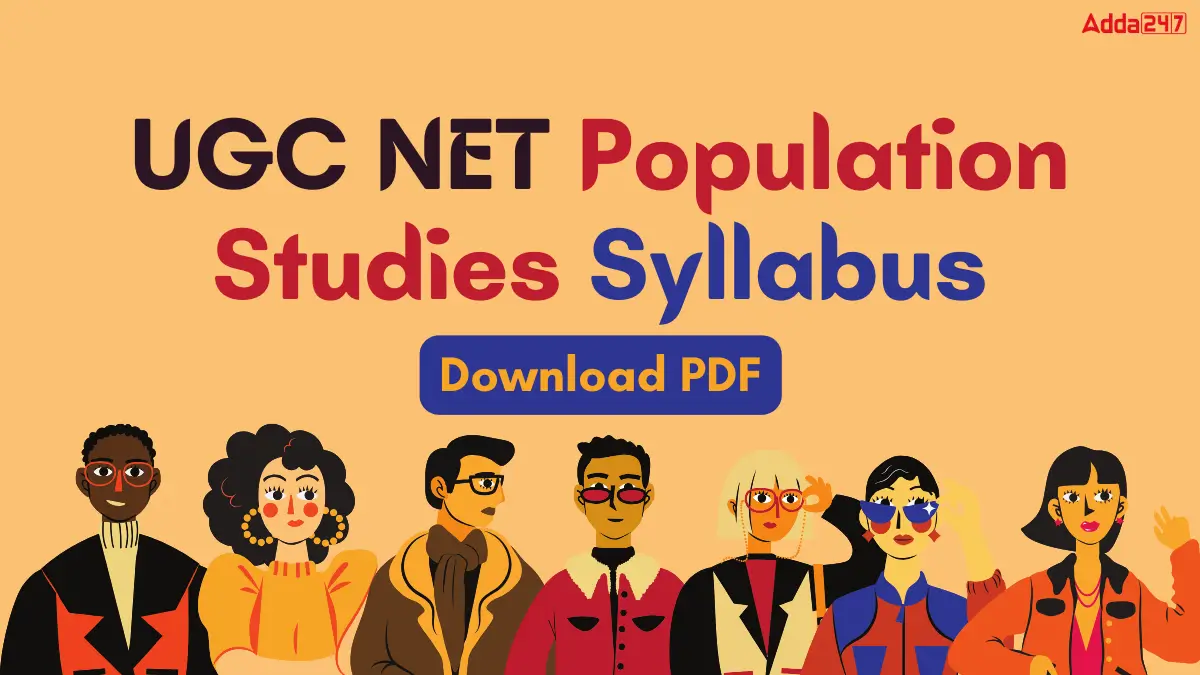Table of Contents
To prepare for the exam, candidates need to understand the complete syllabus. Candidates with Population Studies as the main subject can download the UGC NET Population Studies Syllabus 2025 PDF. This Computer-Based Testing is conducted to assess the candidate’s eligibility in 85 different disciplines.
UGC NET Population Studies syllabus encompasses 10 units, focusing on various aspects of Population Studies. Proficiency in Population Studies will be assessed in Paper II of the UGC NET exam. UGC NET Population Studies syllabus has been made available in both Hindi and English languages, ensuring accessibility to a wider range of candidates. For detailed information on the UGC NET Population Studies Syllabus 2025, please refer to the comprehensive overview provided below.
UGC NET Population Studies Syllabus & Exam Pattern
The UGC NET Population Studies Syllabus 2025 covers a comprehensive range of topics essential for understanding population dynamics and demographic processes. It includes concepts such as population theories, demographic transition, population structure, migration, fertility, mortality, family and household studies, population policies, and population projections.
Candidates are expected to have a deep understanding of demographic methods, data sources, and analytical techniques used in population studies. Additionally, the syllabus emphasizes the interdisciplinary nature of population studies, incorporating insights from sociology, economics, geography, and public health to provide a holistic understanding of population dynamics and their implications for society and policy.
| Feature | Description |
|---|---|
| Number of Papers | 2 |
| Paper I | General Aptitude |
| Paper I – Number of Questions | 100 (2 marks each) |
| Paper II | Population Studies |
| Paper II – Number of Questions | 50 (2 marks each) |
| Paper II – Negative Marking | No |
| Paper II – Duration | 1 hour |
| Negative Marking | No |
UGC NET Population Studies Paper II Syllabus and Exam Pattern
The UGC NET exam is conducted to determine the eligibility of Indian lectures for Assistant Professor posts in universities and colleges. The UGC NET Population Studies Paper II syllabus and exam pattern encompass a diverse range of topics and assessment formats to gauge candidates’ knowledge and understanding in the field of Population Studies. The National Testing Agency (NTA) releases the syllabus and exam pattern for the UGC NET exam.
- Paper II is an objective-type question paper with 50 questions.
- Each question carries 2 marks.
- There is no negative marking for incorrect answers.
- The total duration of the paper is 1 hour.
UGC NET Population Studies Paper II Syllabus
Paper II of the UGC NET Population Studies exam covers ten units. Here’s a breakdown of the syllabus:
Unit I: Introduction and Sources of Population Data
- Nature, scope, and importance of population studies
- Population theories: Malthusian theory, demographic transition theory, optimum population theory
- Sources of population data: Census, vital statistics registration system, sample surveys
Unit II: Methods of Demographic/Population Analysis
- Rate of population growth: Arithmetic, exponential, and geometric growth
- Cohort and cross-sectional indicators: Crude rates, standardized rates, measures of fertility, mortality, and migration
- Methods of population projections: Component method, ratio method
Unit III: Population Composition and Change
- Spatial and temporal changes in the size and distribution of population
- Age and sex structure of population in developed and developing countries
- Composition of India’s population: Demographic, social, economic and cultural factors affecting age-sex structure
- Population ageing: Concepts and measures, trends and patterns of ageing in India
Unit IV: Nuptiality and Fertility
- Nuptiality: Patterns of marriage, factors affecting marriage
- Fertility: Levels and trends of fertility, factors affecting fertility, fertility control programs in India
Unit V: Mortality, Morbidity and Health
- Levels and trends of mortality, factors affecting mortality, causes of death
- Morbidity: Measures of morbidity, factors affecting morbidity
- Health infrastructure in India
Unit VI: Urbanization and Migration
- Levels and trends of urbanization in India and the world
- Causes and consequences of urbanization
- Types of migration: Internal and international migration, factors affecting migration
Unit VII: Population, Development, and Environment
- Population growth and economic development: Population as a resource, population pressure on resources
- Population and environment: Impact of population growth on environment, sustainable development
Unit VIII: Population Issues: Gender and Special Groups
- Gender issues in population studies: Sex ratio, female infanticide, empowerment of women
- Population problems of specific groups: Children, adolescents, aged population
Unit IX: Population & Health Policies and Programmes
- National Population Policy of India: Objectives, strategies, and implementation
- Family planning programs in India: Achievements and challenges
Unit X: Research Methodology and Programme Evaluation
- Research methods in population studies: Data collection methods, sampling techniques
- Programme evaluation: Methods and techniques
UGC NET Population Studies Syllabus 2025 PDF
The direct link to download the UGC NET Population Studies Syllabus 2025 PDF in Hindi and English Has been provided below. Candidates can download the UGC NET Population Studies Syllabus Paper I and Paper II PDF has been provided below.
| UGC NET Population Studies Syllabus PDF | |
| In English | In Hindi |
| Download UGC NET Population Studies Syllabus PDF in English | Download UGC NET Population Studies Syllabus PDF in Hindi |
UGC NET Population Studies Paper II Marking scheme
The marking scheme for UGC NET Population Studies Paper II follows a standardized format. Each correct answer typically carries a weight of 2 marks. The UGC NET Population Studies Syllabus 2025 for Paper II follows a straightforward marking scheme:
| Description | Marks Awarded |
|---|---|
| Correct Answer | 2 marks |
| Incorrect Answer | 0 marks |
| No Answer/Unattempted | 0 marks |
UGC NET Population Studies Qualifying Marks
The minimum qualifying marks for UGC NET Population Studies UGC NET Population Studies Syllabus 2025 for Paper-II are determined by the National Testing Agency (NTA) or the respective exam conducting body. Typically, candidates are required to secure a minimum of 40% aggregate marks in Paper II to qualify for the UGC NET Population Studies Exam.
| Feature | Description |
|---|---|
| Qualifying Criteria | Combined Cut-off Percentile (Paper I + Paper II) |
| Cut-off Percentile Basis | Varies by Year, Subject, and Category |
| Strategy to Qualify | A score above the cut-off percentile for your category in the combined marks. |
| General Category indicative score for Paper II | Around 40% |
| Reserved Category indicative score for Paper II | Around 35% |
How to use the UGC NET Population Paper II Syllabus?
To effectively use the UGC NET Population Studies Syllabus 2025 for Paper II, follow these points:
- Familiarize Yourself: Begin by thoroughly reading through the entire syllabus to understand the scope and depth of topics covered.
- Organize Topics: Divide the syllabus into manageable sections or units based on the provided outline.
- Create a Study Plan: Develop a study plan that allocates sufficient time to cover each unit comprehensively.
- Gather Resources: Collect relevant study materials, including textbooks, reference books, research papers, and online resources aligned with each topic in the syllabus.
- Study Systematically: Study each topic systematically, starting with the foundational concepts and progressing to more advanced topics.
- Practice Questions: Solve practice questions and previous year’s papers to familiarize yourself with the exam pattern and assess your understanding of the topics.




 MPPSC Assistant Professor Syllabus 2026,...
MPPSC Assistant Professor Syllabus 2026,...
 REET Mains Syllabus Level 2, Download Su...
REET Mains Syllabus Level 2, Download Su...
 UGC NET Law Syllabus 2025, Download PDF ...
UGC NET Law Syllabus 2025, Download PDF ...












